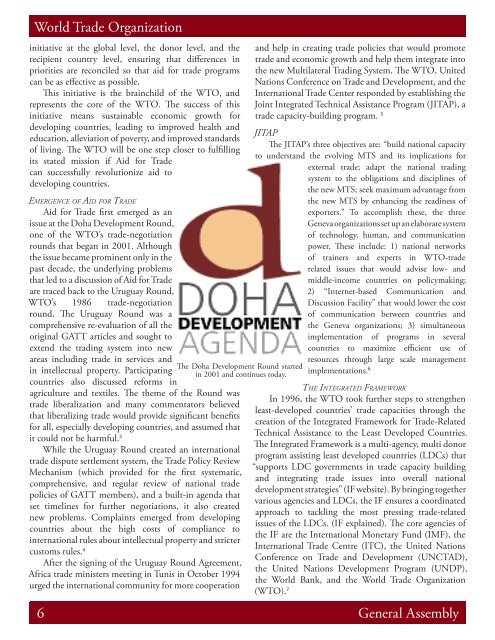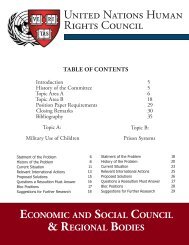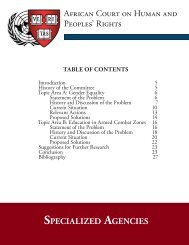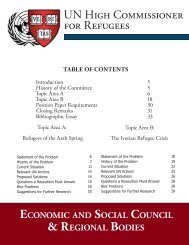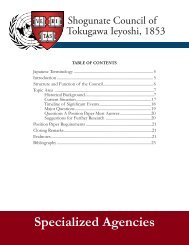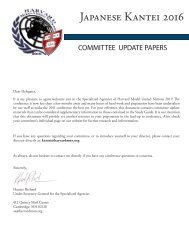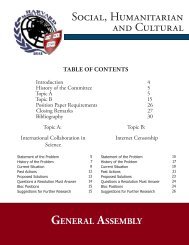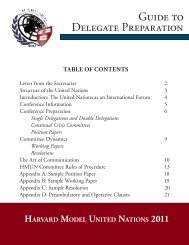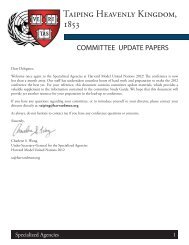World Trade Organization - Harvard Model United Nations
World Trade Organization - Harvard Model United Nations
World Trade Organization - Harvard Model United Nations
Create successful ePaper yourself
Turn your PDF publications into a flip-book with our unique Google optimized e-Paper software.
<strong>World</strong> <strong>Trade</strong> <strong>Organization</strong><br />
initiative at the global level, the donor level, and the<br />
recipient country level, ensuring that differences in<br />
priorities are reconciled so that aid for trade programs<br />
can be as effective as possible.<br />
This initiative is the brainchild of the WTO, and<br />
represents the core of the WTO. The success of this<br />
initiative means sustainable economic growth for<br />
developing countries, leading to improved health and<br />
education, alleviation of poverty, and improved standards<br />
of living. The WTO will be one step closer to fulfilling<br />
its stated mission if Aid for <strong>Trade</strong><br />
can successfully revolutionize aid to<br />
developing countries.<br />
Emergence of Aid for <strong>Trade</strong><br />
Aid for <strong>Trade</strong> first emerged as an<br />
issue at the Doha Development Round,<br />
one of the WTO’s trade-negotiation<br />
rounds that began in 2001. Although<br />
the issue became prominent only in the<br />
past decade, the underlying problems<br />
that led to a discussion of Aid for <strong>Trade</strong><br />
are traced back to the Uruguay Round,<br />
WTO’s 1986 trade-negotiation<br />
round. The Uruguay Round was a<br />
comprehensive re-evaluation of all the<br />
original GATT articles and sought to<br />
extend the trading system into new<br />
areas including trade in services and<br />
in intellectual property. Participating<br />
countries also discussed reforms in<br />
agriculture and textiles. The theme of the Round was<br />
trade liberalization and many commentators believed<br />
that liberalizing trade would provide significant benefits<br />
for all, especially developing countries, and assumed that<br />
it could not be harmful. 3<br />
While the Uruguay Round created an international<br />
trade dispute settlement system, the <strong>Trade</strong> Policy Review<br />
Mechanism (which provided for the first systematic,<br />
comprehensive, and regular review of national trade<br />
policies of GATT members), and a built-in agenda that<br />
set timelines for further negotiations, it also created<br />
new problems. Complaints emerged from developing<br />
countries about the high costs of compliance to<br />
international rules about intellectual property and stricter<br />
customs rules. 4<br />
After the signing of the Uruguay Round Agreement,<br />
Africa trade ministers meeting in Tunis in October 1994<br />
urged the international community for more cooperation<br />
The Doha Development Round started<br />
in 2001 and continues today.<br />
and help in creating trade policies that would promote<br />
trade and economic growth and help them integrate into<br />
the new Multilateral Trading System. The WTO, <strong>United</strong><br />
<strong>Nations</strong> Conference on <strong>Trade</strong> and Development, and the<br />
International <strong>Trade</strong> Center responded by establishing the<br />
Joint Integrated Technical Assistance Program (JITAP), a<br />
trade capacity-building program. 5<br />
JITAP<br />
The JITAP’s three objectives are: “build national capacity<br />
to understand the evolving MTS and its implications for<br />
external trade; adapt the national trading<br />
system to the obligations and disciplines of<br />
the new MTS; seek maximum advantage from<br />
the new MTS by enhancing the readiness of<br />
exporters.” To accomplish these, the three<br />
Geneva organizations set up an elaborate system<br />
of technology, human, and communication<br />
power. These include: 1) national networks<br />
of trainers and experts in WTO-trade<br />
related issues that would advise low- and<br />
middle-income countries on policymaking;<br />
2) “Internet-based Communication and<br />
Discussion Facility” that would lower the cost<br />
of communication between countries and<br />
the Geneva organizations; 3) simultaneous<br />
implementation of programs in several<br />
countries to maximize efficient use of<br />
resources through large scale management<br />
implementations. 6<br />
The Integrated Framework<br />
In 1996, the WTO took further steps to strengthen<br />
least-developed countries’ trade capacities through the<br />
creation of the Integrated Framework for <strong>Trade</strong>-Related<br />
Technical Assistance to the Least Developed Countries.<br />
The Integrated Framework is a multi-agency, multi donor<br />
program assisting least developed countries (LDCs) that<br />
“supports LDC governments in trade capacity building<br />
and integrating trade issues into overall national<br />
development strategies” (IF website). By bringing together<br />
various agencies and LDCs, the IF ensures a coordinated<br />
approach to tackling the most pressing trade-related<br />
issues of the LDCs. (IF explained). The core agencies of<br />
the IF are the International Monetary Fund (IMF), the<br />
International <strong>Trade</strong> Centre (ITC), the <strong>United</strong> <strong>Nations</strong><br />
Conference on <strong>Trade</strong> and Development (UNCTAD),<br />
the <strong>United</strong> <strong>Nations</strong> Development Program (UNDP),<br />
the <strong>World</strong> Bank, and the <strong>World</strong> <strong>Trade</strong> <strong>Organization</strong><br />
(WTO). 7<br />
6<br />
Specialized General Assembly Agencies


